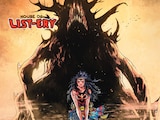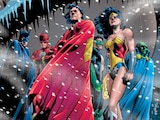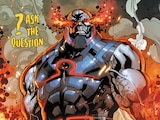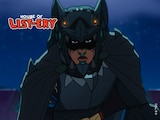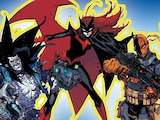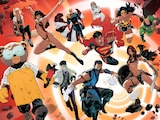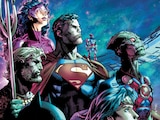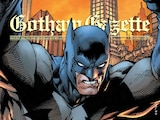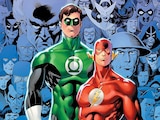Bruce Wayne is a man with a plan. A meticulous, detailed, obsessive (probably unhealthily so) plan. Whether he's deciding how to create an alter-ego based around his greatest fear or working out how to defeat the crime bosses of Gotham, Batman always has a roadmap and ultimately a guide to whatever he's about to embark on. In THE BATMAN WHO LAUGHS #3, Scott Snyder and Jock give us more of an insight into just how vital that aspect of Bruce's life and preparation is, opening the door for a conversation about how structure can be a way of dealing with massive trauma, and showcasing just how devastating it can be for us and those around us when we lose control of the coping mechanisms that we've put into place.
With the Joker's toxin coursing through his veins, Bruce has found himself pushed to the limit. During The Batman Who Laughs, we've learned about his ultimate endgame plan, “Last Laugh,” which sadly for Bruce and Gotham is something that the alt universe versions of him are also aware of. This is one of the thematic threads throughout The Batman Who Laughs—how does Bruce plan for the worst when he's fighting the only foes who could possibly know and undo his schemes...multiple versions of himself!

It's not just Bruce who tries to gain control through routine, though, as the issue opens with Batman and Gordon visiting the latter's son, James Gordon, Jr. A murderous psychopath who has since reformed, it's a powerful couple of pages as James Jr. tries to focus on his work, rigorously checking and cataloging stacks of boxes rather than facing the men who are asking for his help. Sadly, Bruce cannot see the parallels between himself and the troubled kid, and tries to incite violence from him, disregarding the young man's mental health and rehabilitation, showing that the Bruce who once cared so much about Gotham and its inhabitants is already beginning to lose his way to the venom that’s been running through him since the end of issue #1.
This series really feels like it's harking back to classic Bat-stories like BATMAN: PREY, which delve into Bruce's psyche and ask us to interrogate the hero of Gotham, his choices and ultimately himself. As we get further into this series, Snyder and Jock begin to make us question every decision that Bruce makes, as we get to learn more about him while also remaining unsure of how reliable of a narrator he actually is due to his ongoing transformation. It plays on one of the most feral and human fears: the loss of control of our sense of self, of our person and of our moral compass.

As comics are obviously an inherently visual medium, we're following this journey through Jock and David Baron's chilling art, which does a brilliant job of putting across the nightmarish instability of Bruce's transformation. The juxtaposition between Bruce's childhood memories—shown as polished and slick, seeming to represent a time of a calm and normality in his life—and the jagged lines, shadowed corners and broken edges of his present is clear. Bruce is shattered, as is the world around him. As we move deeper into his Joker-induced madness, things become visually more nightmarish, even when Bruce isn't around to witness it. This reaches a peak late in the issue, when Alfred describes the Joker escaping and we see him with his heart splayed across his chest, a horrific grimace stretched across his face like a scar.
Another thing to note is Jock's choice to be sparse with architecture and backgrounds. We're so used to the sprawling vastness of Gotham, a city which is arguably just as much of a character in the comics as Batman himself. Here, though, we're always focused on the people within the metropolis rather than the iconic locale itself. It's a great reminder that this story is very much about the madness of the man rather than the madness of the city that he's dedicated his life to protecting.

Throughout his 80-year history, Bruce has been driven by never losing control. He's defined by the one night of his life where he didn't have any control over what happened to him, and he's convinced himself that as long as he never loses that again, he'll be okay. It's why so many of the most monumental moments in his life (both in continuity and out of it) have been shaped by him almost losing control. Here we see him finally letting go completely, allowing himself to be consumed by his greatest fear, his biggest foe and his ultimate weakness, and it likely means that things are about to get a whole lot worse for Bruce Wayne and Gotham.
THE BATMAN WHO LAUGHS #3 by Scott Snyder, Jock and David Baron is now available in print and as a digital download.
Rosie Knight writes about comics, movies and TV for DCComics.com and DCUniverse.com. Be sure to follow her on Twitter at @RosieMarx.



